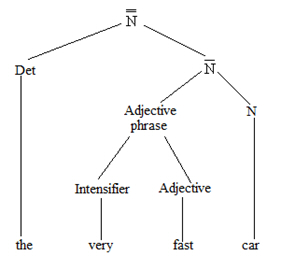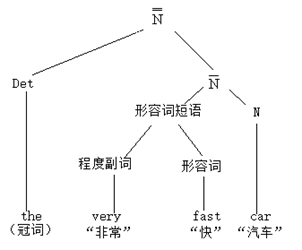X-bar
()X-杠
A system of grammatical analysis developed in generative linguistics as an alternative to traditional accounts of phrase structure and lexical categories. It is argued both that the rules of phrase-structure grammar need to be more constrained, and that more phrasal categories need to be recognized. In particular, within the noun phrase, the need is felt to recognize intermediate categories larger than the noun but smaller than the phrase, e.g. very fast or very fast car in the phrase the very fast car. These intermediate categories, which have no status in previous phrase-structure models, are formally recognized in X-bar syntax by a system of X-bars, each of which identifies a level of phrasal expansion. For example, the following tree illustrates two levels of expansion for (‘N-bar’ and ‘N-double-bar’):

Each of the bar categories corresponding to X is known as a bar-projection of X. The value of recognizing intermediate categories in this way is widely agreed, but discussion continues about the number of categories which need to be recognized, and how far it is possible to generalize rules of category formation throughout a grammar.
生成语言学建立的一种语法分析系统,用来取代短语结构和词汇范畴的传统说明。按这个系统,一方面短语结构语法规则须受更多的制约,另一方面须承认更多的短语范畴。具体而言,在名词短语内,似有必要承认一些大于名词而小于短语的范畴,例如短语the very fast car“那辆非常快的汽车”内的very fast“非常快”或very fast car“非常快的汽车”这样的中间范畴,他们在以往的短语结构模型中没有地位,而在X-杠句法中由一X-杠系统作形式上的区分,每个X-杠等同于一个短语扩展层面。例如,下面的树表示N的两个扩展层面(“N-杠”和“N-双杠”):

对应于X的每个杠范畴称作X的杠投射。
以这种方式承认有中间范畴存在,其价值已被广泛接受,但需要承认的范畴的数目有多少,整部语法对范畴形成规则的概括能达到多大程度,这些问题还在不断讨论之中。








